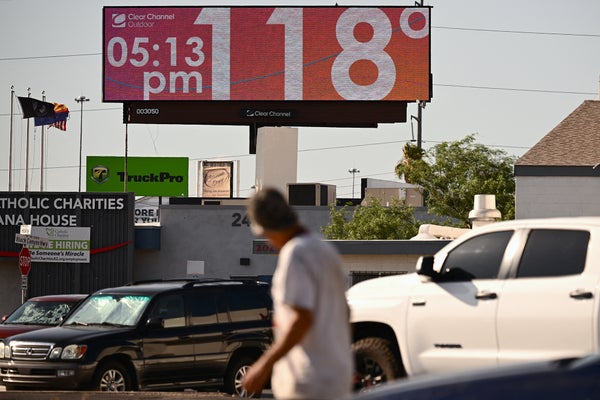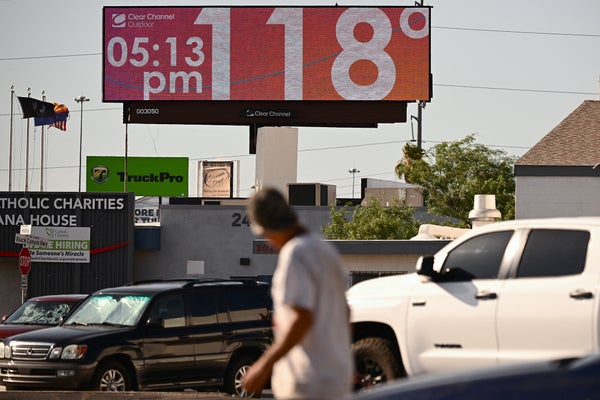Heat Waves Need FEMA’s Help
Heat waves are costly and kill more people each year than hurricanes, tornadoes and floods combined, but because FEMA doesn’t count them as disasters, communities miss out on important resources

A billboard displays a temperature of 118 degrees Fahrenheit during a record heat wave in Phoenix, Arizona on July 18, 2023.
Patrick T. Fallon/AFP via Getty Images
It is summer in the U.S., and heat waves have started to sweep across the country. These disasters cause at least hundreds of deaths each year—and more deaths annually than hurricanes, tornadoes and floods combined. Heat also causes major infrastructure damage such as train derailments and road buckling. In fact, the Southern/Midwestern drought and heat wave was the costliest ($14.5 billion) weather event of 2023. Yet no heat event has ever been declared a disaster by the Federal Emergency Management Agency (FEMA), meaning affected communities do not have access to resources from our nation’s disaster agency.
With our climate crisis making heat waves longer or more intense, this must change.
One solution popular with politicians, newspapers and now biodiversity, health and labor groups is to add heat waves to the list of disasters in the Stafford Act, the main legislation governing FEMA action.
On supporting science journalism
If you’re enjoying this article, consider supporting our award-winning journalism by subscribing. By purchasing a subscription you are helping to ensure the future of impactful stories about the discoveries and ideas shaping our world today.
And while true solutions are more complicated than adding heat waves to the Stafford Act, more importantly, emergency management officials want these changes. I am one of them—formerly a division chief in California governor Gavin Newsom’s Office of Emergency Services and now a professor studying the intersection of public health and emergency management at Cornell University.
We need FEMA to declare heat a disaster for a couple of reasons. First, designating heat and other disasters that damage health more than infrastructure could help focus relief efforts such as worker protections. Second, once the federal government designates an event a disaster, FEMA and other federal agencies can react, offering a state or municipality numerous programs that help communities prepare for, respond to and recover from disasters. Communities nationwide view these two goals as increasingly critical as they are pushed beyond their limits by extreme heat.
The Stafford Act is an “illustrative list not an exhaustive list,” my colleagues and I often say, a point supported by the eventual declaration of COVID as a disaster. It wasn’t part of the Stafford Act list. In fact, our nation’s emergency managers are responding to an ever-increasing variety of disasters, including opioid use, homelessness and the needs of asylum seekers, highlighting the officials’ critical role in evolving emergencies.
So if emergency managers want assistance with heat (and wildfire smoke and other people-centered disasters), we need to give them the ability to measure heat-wave severity in terms compatible with current disaster policy.
This means collecting real-time data of costs at the county level and ensuring that health impacts are included in those costs.
A core tenet of emergency management is that events become disasters when the amount of damage exceeds resources. Although the phrase is simple, the decision-making is complex. For instance, is a tornado a disaster if it hurts no one and destroys no infrastructure? FEMA has been increasingly using quantitative methods to make decision-making transparent to impacted communities. However, the drawback is that anything unquantified, or quantified only after the danger is passed, such as excess mortality caused by a heat wave, is excluded.
To make it easier to classify heat as a federal disaster, we need real-time data to declare the disaster promptly. Most estimates of heat-wave mortality are retrospectively available too late to meaningfully respond, which occurs because traditional autopsy methods vastly undercount heat-deaths, necessitating estimation through slower statistical methods. In addition, FEMA requires that we measure effects economically, so we need quick cost calculations. And because heat waves have heavy health and mortality impacts, cost estimates must monetize health impacts. Finally, cost summaries must be available for each county, state, territory and tribal nation, because those are the jurisdictions eligible to receive a disaster declaration.
The good news is that many federal agencies, including FEMA, have existing methods that could be combined to form the tools we need. Real-time health-effect measurements include the National Syndromic Surveillance System and the excess-death and flu-burden calculations from the Centers for Disease Control (CDC). Ways to measure extreme heat effects are needed for these existing methods, and CDC’s Heat and Health Tracker is a great step in this direction. Real-time estimates of health effects should then be converted to costs using the Value of a Statistical Life, which FEMA’s National Risk Index already uses ($11.6 million of economic loss per death) at a county level to help communities plan for major hazards.
FEMA, CDC and other federal partners can combine these methods to give communities the tools to identify when a heat wave escalates into a heat disaster. To show this is possible, colleagues and I developed a prototype tool to estimate the real-time mortality for smoke waves, a people-centered disaster with similar challenges to heat waves.
In addition to making the policy changes that would make heat waves (and smoke waves) disasters that FEMA can respond to, we need to define FEMA’s role in assisting communities in need and ensuring proper funding for these activities. In a recent memo, colleagues and I suggest ways FEMA can respond based on how it responds to other disaster types. Examples include public messaging, funding emergency activities like shelters, deploying personnel for survivor case management, providing equipment like trailers for temporary housing, and coordinating with other agencies for additional support. This is work many cities and states currently do, but federal support should be available when keeping the community safe exceeds the community’s resources. FEMA is already stepping up with a necessary shift to proactive, whole-community resilience approaches, including by establishing their resilience office and resilience guidance.
Of course, none of this will actually happen if Congress modifies the Stafford Act but fails to allocate FEMA a sufficient budget. The Disaster Relief Fund, through which Congress allocates major funding for FEMA, is expected to be billions of dollars in deficit by September 2024. Furthermore, FEMA has delayed payments in response to the uncertainty of funding through Congressional budget negotiations. The consideration of new disasters without additional taxpayer support and federal funding would harm FEMA’s ability to act in the ways we already rely on.
Heat waves, smoke waves, and other people-centered disasters aren’t going away any time soon; in fact, they are expected to worsen. Our emergency managers want to help, and need the policy infrastructure to do so. Fortunately, the tools to act are already in reach.
This is an opinion and analysis article, and the views expressed by the author or authors are not necessarily those of Scientific American.

